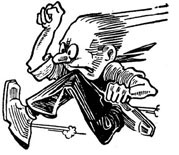
The Power & the Glory
HARVARD DIARY
Those words, “Thine is the kingdom and the power and the glory,” are not meant to be the easily recited piety so many of us find ourselves uttering — words and more words tossed toward the mystery of time and space, of infinity, that separates us from God’s being and knowledge.
Indeed, I suspect many of us have to contend with that first word “thine” — we know to insist upon it, to stress it when speaking it, perhaps to italicize it when writing it, but we also know the issue is ironic as well as rhetorical: For long stretches of our daily life we are fully convinced that “the power and the glory” are surely to be found in one or another aspect of this secular, materialist world, which some hope and, yes, pray is ours for the grasping.
The same holds for Graham Greene’s lowly, bedeviled, pursued “whiskey priest” in the most memorable and morally challenging of his novels, The Power and the Glory — we meet the priest initially as one with a keen eye for wine and women, and no interest in standing up for principle at the risk of suffering death. Still, he most certainly is a humble, haunted, and hunted priest — interestingly, he is given no name. He is very much like Ralph Ellison’s protagonist in Invisible Man — both men are invisible to others; both are on pilgrimages; both are witnesses to a world of conceit and deceit; both are able to see, gradually, the blindness of others — and yes, their own blindness, which slowly begins to lift as a consequence of a series of experiences with those others. Of course, Ellison has faith in an enlightenment that progressively takes place when human beings by design or accident or luck stumble into one another and become teachers. His story’s hero may still be in hiding from the world (and himself), a contemporary version of Dostoevsky’s “underground man,” but more and more light descends on this man’s darkness — a bold symbolism for Ellison to use: A man whose skin is black paradoxically gets enlightened by virtue of the shadowy, dingy white world whose corruptions and phoniness he keeps meeting on his trek from the country to the city, from America’s South to its North.
Similarly, Greene’s priest is constantly on the move; he is pursued by the 1930s Mexican version of institutionalized hate — though, of course, in a novel such an abstraction becomes the stuff of particular human experience. Greene’s priest is trying to escape those who would capture and kill him in the name of a revolution’s “progress” and “purity” — yet another fiercely self-righteous and unforgiving ideological insistence on the part of man the rationalist and reformer. Rather too readily, the reader links arms with this hounded priest, wants him to escape his relentless persecutors. Indeed, for a while Greene gives us one of his detective stories, a “criminal” on the lam, the police after him. Yet, the lieutenant who heads the search can’t even recognize the object of his hunt when the man is right in front of him — a writer’s show of cleverness, but in this case a writer’s effort, also, to move beyond a conventional crime story to a larger, more ambitious examination of human benightedness: the illusions and worse of those who persecute others, but also the self-deceptions of those who are potential victims. For a good part of the novel, after all, the priest is as much a stranger to himself as he is beyond the recognition of those out to capture him.
You May Also Enjoy
I first met Christopher Lasch in the middle 1960s. My wife, Jane, and I had…
For our own sons and daughters we want no drug abuse and a sexuality that is kept under constraints. For others "below" us, quite another point of view obtains.
Sloth is acceding to the apparent in a religious tradition, the conventional, the readily accessible, and thereby letting the matter (that of one's soul's obligations) rest there.

